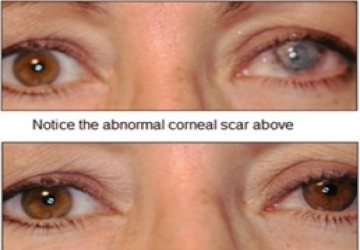
• Hybrid contact lenses
Hybrid contact lenses combine a hard highly transmissible oxygen-permeable core with a soft environment. These hybrid contact lenses are specially designed for keratoconus cases, and the rigid center area fits over the cone-shaped cornea of the eye to increase eye comfort.
Hybrid contact lenses provide visual clarity as in rigid, gas permeable contact lenses, and user comfort that rivals that of soft contact lenses. These lenses are available in a wide range of factors to provide good fixation that matches and matches the irregular shape of the eye's conical cornea.
• Contact lenses that cover the white part of the eye completely or partially
• PROSTHETIC LENSES, EMULATOR
Because of the difficulty in fixing contact lenses on the cone-shaped eye, patients with severe cases of the disease often need a lens that covers the hard white part of the eye, which doubles as an artificial crust on the eye.
Dr. Hanatera pointed to an example of these lenses that are a synthetic alternative to the ocular surface ecosystem and have been in use since the 1990s. This type of treatment restores visual function, supports healing, reduces symptoms and improves quality of life for patients with complex diseases of the cornea of the eye such as keratoconus.
Another example of this type is what is called a biometric lens. This type of lens is specially designed to accommodate the irregularities in the shape of each eye for each individual case. This treatment begins with taking an eye print by imaging the subtle curves of the entire surface of the eye. Then the attending physician sends this fingerprint to a 3D-ray lab. The obtained data and information are fed to a computer programmed device that works to produce the industrial lens with the required specifications.
With us, you are in safe hands, and we wish you a speedy recovery